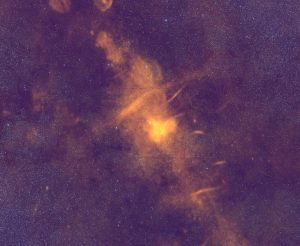The Very Large Array sees fountains of hot gas erupting from a beastly black hole in the heart of a large galaxy known to radio astronomers as Hercules A. For millions of trillions of miles, these jets shoot through space, finally slowing when they reach ancient gaseous hiccups left behind by this galaxy’s earliest days of star-forming fury.


ALMA First Image
In this composite image of the merging cores of the Antennae Galaxies, optical (white and pink), radio (blue) and millimeter/submillimeter (orange and gold) images are combined to show the history and future of star formation. The optical image represents stars that are shining now. The radio image highlights gas that is probably too thin to become a star, and at the mm/submm wavelengths we can see the areas where new stars will likely form.

VLA Reveals Large Hydrogen Disk in UGC 5288
Dwarf galaxy UGC 5288 is 16 million light-years from Earth (seen here in pink). The Very Large Array (VLA) found that it is surrounded by a huge disk of hydrogen gas (purple) that has not been involved in the galaxy’s star-formation processes and may be primordial material left over from the galaxy’s formation.

Old, New, and Future Stars in NGC 3596
This gorgeous face-on spiral galaxy is called NGC 3596. This image combines Hydrogen-alpha emission (red), visible light in the R-band (white), and neutral hydrogen 21cm gas emission (blue) from the Very Large Array (VLA). What you see when you combine the invisible waves with visible ones is the enormous shroud of gas surrounding this galaxy. Mature stars twinkle in white, new stars shine their nursery clouds in reds, and the gas for future stars glows in blue.

Making Stars in NGC 4449
Radio imaging with the Very Large Array (VLA) captures newborn massive star clusters as they emerge from their birth material in the galaxy NGC 4449. These “super star clusters” contain tens to hundreds of thousands of stars. The young stars produce hot ionized gas which is detectable at radio wavelengths, shown in red here. An image from the Sloan Digital Sky Survey shows the visible starlight in gold.

The Center of our Milky Way Galaxy
Through the layers of dust that shroud the center of our galaxy from optical telescopes lurks a complex hub of activity. In this wide field Very Large Array (VLA) image, the supermassive black hole in the center of our Galaxy shines brightly in radio waves. Surrounding it are the winds and rivers of material caught in its gravitiational and magnetic wakes. Bubbles of star-formation and supernovas scatter around.





